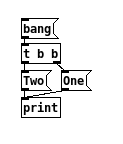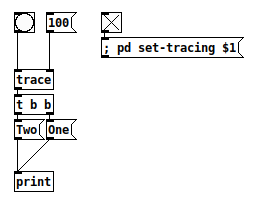Probably best to skip this post and just read the next, will leave it here since it could result in useful replies from those who understand the internals of pd and perhaps some people here are as interested in these sorts of details as I am,
@ddw_music I think pd uses the stack in exactly the same way but the difference here is that pd lacks a return stack (and stack/instruction pointer manipulation); abstractions are actually macros which are expanded, they are not functions which are pointed to and returned from. The unique ID given to an abstraction when it is expanded allows us to use them sort of like functions and mimic scope but pd is a very simple globally scoped imperative language.
Edit: I guess pd does have very basic IP manipulation, [send] is essentially a goto. The big difference with pd and dataflow is that the IP carries a bit of our data with it as it moves through the patch. The result of an operation does not go onto the stack but is carried with the IP. Or maybe data is only carried with the IP in a conceptual sense and result actually is TOS? Think I will have to investigate pd's stack when I have the time.
Edit2: I guess wires are also gotos then. I suppose what this really is is that pd is a 2d language, [send] and wires only seem like gotos if we try and think of pd as a 1d text language.
Edit3: (last one) Pd would have a return stack, but the returns always point to branches. A [t b b b b] is essentially push and drop commands for the return stack, rightmost bang pushes, leftmost drops. End of the branch having an explicit pop so it can return to the [trigger] or where ever the code branched. More like other languages than I thought in stacks, assuming my reasoning is sound, the big difference being that pd has no concept of anything remotely function like. IP probably carries the pointer as well as the data, would save popping everytime it return which means no return stack and back to my original point of pd lacking a return stack (subrosa edit4.) But that would mean the IP caries a return stack in a rather funge like way, which it might, the return stack is part of the IP object and not the interpreter proper (subrosa edit5.)






 They're structured, provide a convenient way for exiting deeply nested loops, and feel similar to Java's exception framework.
They're structured, provide a convenient way for exiting deeply nested loops, and feel similar to Java's exception framework. well, there's a time and place for everything. There are gotos in SuperCollider's C++ codebase, iirc mainly in the long
well, there's a time and place for everything. There are gotos in SuperCollider's C++ codebase, iirc mainly in the long